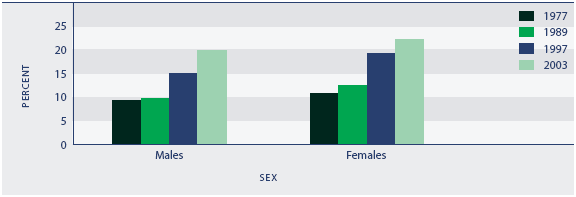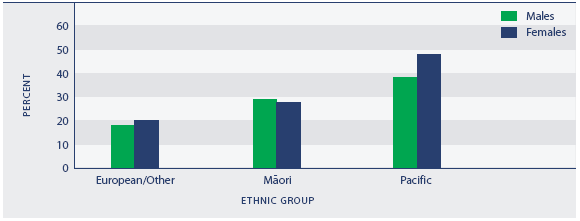Obesity
Definition
The proportion of the population aged 15 years and over who are obese.
Obesity is defined as having a Body Mass Index (BMI) greater than 30 for European and Other ethnicities, or greater than 32 for Māori and Pacific peoples. For the population aged under 15 years, the measure is the proportion of children aged 5–14 years whose BMI meets internationally defined thresholds of obesity. 31
Relevance
Obesity is associated with heart disease, diabetes, strokes, high blood pressure and some cancers. The increase in the prevalence of obesity has been identified as a major cause of the projected increase in diabetes.32
Current level and trends
In 2003, 21 percent of adults aged 15 years and over were obese, an increase from 17 percent in 1997. In 2002, 10 percent of children aged 5–14 years were obese.
Between 1977 and 1989, there was a small increase in the prevalence of obesity among New Zealand adults aged 15–74 years. Between 1989 and 2003, male obesity doubled from 10 percent to 20 percent, and female obesity increased from 13 percent to 22 percent.33 The major drivers of the increase in obesity rates have been changing dietary and physical activity patterns, reflecting an environment that promotes the over-consumption of energy-dense foods and drinks and limits the opportunities for physical activity.34
Figure H5.1 Prevalence of obesity, total population aged 15–74 years, by sex, 1977–2003

Source: Ministry of Health (2004b) Table 19, p 89
Age and sex differences
Age-standardised prevalence rates for 2003 showed no significant sex difference in the proportion of adults who were obese (males, 19 percent; females, 21 percent).
Obesity increased with age up to the 55–64 years age group (males, 29 percent; females, 31 percent), then declined in the older age groups. This age pattern may reflect in part a cohort effect.35 Among children aged 7–14 years in 2002, females were more likely than males to be obese.
Table H5.1 Prevalence (%) of obesity, population aged 15 and over, by age group and sex, 2003
| |
15–24 |
25–34 |
35–44 |
45–54 |
55–64 |
65–74 |
75+ |
Total 15+ |
| Males |
9.7 |
16.1 |
21.0 |
26.1 |
29.0 |
24.0 |
19.4 |
19.2 |
| Females |
12.4 |
20.7 |
22.0 |
24.6 |
30.9 |
27.2 |
17.1 |
21.0 |
Source: Ministry of Health (2004a) pp 85–86
Ethnic differences
Obesity is more prevalent among Pacific peoples and Māori than other ethnic groups. Among adults in 2003, the age-standardised obesity prevalence rate was 48 percent for Pacific females and 38 percent for Pacific males. For Māori adults, the figures were 28 percent for females and 29 percent for males. This compares with 20 percent for European/Other females and 18 percent for European/Other males. Among children aged 5–14 years in 2002, there was a similar pattern (Pacific children: 31 percent and 26 percent for females and males respectively; Māori children: 17 percent, 16 percent; European/Other: 6 percent, 5 percent).
Figure H5.2 Age-standardised prevalence of obesity, population aged 15 years and over, by ethnic group and sex, 2003

Source: Ministry of Health (2004a) Tables 13 and 14, pp 103–104
Note: Rates are age-standardised using the WHO world population
Obesity has increased for all groups since 1989, but there was little change in the rates for Māori between 1997 and 2003.36
Socio-economic differences
The association between socio-economic status and female obesity has been found consistently over time and using different measures of socio-economic status. For example, in 2003, 28 percent of females living in quintile 5 small areas (the most disadvantaged fifth of small areas in New Zealand ) were obese, while only 16 percent of those in quintile 1 areas were obese. The link between male obesity and socio-economic status is less well-established.37
International comparison
New Zealand has a relatively high prevalence of obesity compared with other OECD countries, with a rate of 21 percent in 2003, compared to an OECD median of 13 percent. New Zealand ranked 24th out of 30 countries reporting obesity prevalence in 1999–2004. However, most countries use the self-reporting method to measure obesity whereas New Zealand and four other countries use actual measurements recorded by an interviewer. New Zealand's rate was lower than the other four countries: the United States (with the highest rate of obesity, at 32 percent in 2004); the United Kingdom (23 percent in 2004), Canada (22 percent in 2004) and Australia (22 percent in 1999). Of all countries, Japan and Korea had the lowest prevalence of obesity (3 percent in 2003 and 2001, respectively).38
|


